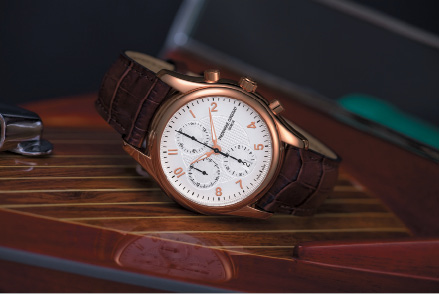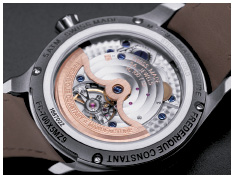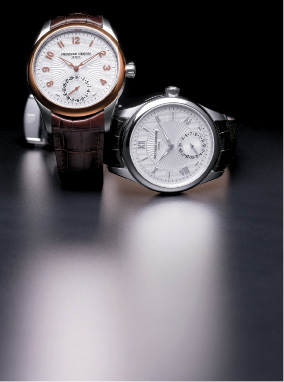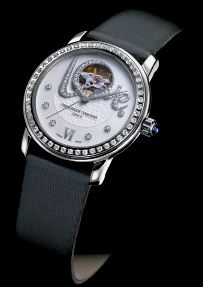


![]()
ONLINE

Accessible Luxury
Editors’ Note
Peter Stas studied at Erasmus University in Rotterdam and obtained a Doctorandus degree in business economics. Between 1987 and 1989, he worked for a Loyens company in New York. In 1988, he created his own company. In his leisure time, he was able to further his private plan for making affordable mechanical wristwatches. In 1989, he started working for Philips in Eindhoven in The Netherlands, and in 1991, departed for a six-year tour of duty in Hong Kong. He became a friend of the manager of Mido (the fine old watch brand founded in Bienne in 1918), as well as met his partner Philippe Bouchet, who managed a watch parts company in Geneva. He assembled by hand two each of six quartz wristwatch models, gathered as “The 18th-Century Collection,” and each had ‘Frédérique Constant’ enameled on its dial. Frédérique Constant’s first automatic mechanical wristwatch arrived in 1992. In 1997, Stas established an office in Carouge, on the outskirts of Geneva.
Company Brief
Based in Plan-les-Ouates, Geneva, Frédérique Constant (www.frederique-constant.com) is an independent family-owned watch manufacturer involved in all stages of watch production, from initial design to final assembly and quality control. Each watch is assembled by hand and extensively controlled with the latest equipment to ensure maximum quality.
As a result of the impact of the global economic crisis on the luxury segment, how much of a toll has that taken on the business for the brand, and are there certain markets that are still strong?
Following the collapse of Lehman Brothers, our growth started to rapidly reduce. In September 2008, we were up 21 percent, but by October, it was around 18 or 19, November was zero, and December was minus. For the whole year of 2008, we were still plus-16 percent.
The first quarter of 2009 only got worse, even in our situation. The whole industry literally tanked. For us, that continued up to the end of March. But we had made the decision at the end of 2008 that all the developments we had on the drawing board were going to be introduced, because we needed new products to sell. We introduced our new concepts in March and started the first deliveries. In the second quarter, we caught up, and were actually stronger compared to 2008. As of the second quarter of 2009, we were able to maintain more or less the same sales figures as 2008. We ended 2009 a small percentage down compared to 2008, but because we introduced 52 new products with our Accessible Luxury pricing, we were able to expand into more top retailers and were pushed by them. So we have been hit much less than most of our colleagues.
When you launch new products, do you stick with the tradition of the brand or are you looking for a completely new style?
That is the other reason we have done much better than the rest. We are classical to the extent that some people say we are boring. But boring is good. When people spend a few thousand on a watch now, they want to make sure it’s still in fashion next year, and we’re not “fashion” at all. So we don’t have to change anything – and we don’t. We have been doing this for 20 years and we liked classical watches from the beginning; we’ve continued to make classical watches, and that is exactly what the market wants now.
During this downturn, luxury has almost become a negative word. How do you define what the word means, and is it hard to get the message across that luxury today can still mean value?
People always think our watches are more expensive than they really are. We start at about $600 and many of them are below $2,500 – that’s what we call Accessible Luxury. But there are many people in the world for whom a watch of $1,000 is still a serious investment. So everything is relative.
We don’t feel the negative connotation with luxury too much. We have a few “bling” pieces in the line, but if you go through our catalog, the designs are stylish and discrete and even our watches with diamonds for ladies are not too showy.
It would seem this is a brand that has a very broad market. How do you define that target for you?
Our core target is businessmen from 30 to 45 years of age, the ones who are moving up the ladder; they have two or three kids in school, and the house needs to be paid off. In a watch shop, the girl or guy behind the counter will suggest this client have a look at Frédérique Constant, and tell him that, while it’s still a relatively young brand, it will fit his needs.


Runabout
Are there key global markets that you’re most focused on developing for the brand?
Markets that are important for the brand are Switzerland, France, and China. The two countries that seriously dropped last year were Russia and Japan. Historically, Japan is one of our oldest markets, but it is also a market now where I see fewer opportunities.
I think Russia will come back – it’s already coming back. The oil price went up so at least one of the problems is solved for them.
We see possibilities to rapidly develop in the Americas. In Europe, we continue to pay attention because it accounts for 41 percent of our turnover. That percentage didn’t come down but it deserves attention, with Germany being one of the key countries. On the Asian side, we continue to focus on the Greater China area. India is not yet a priority because we still have to prove ourselves there, but we have started to work on it.
Has the focus on male versus female shifted at all, and where do you see that going?
Yes, that has shifted. We used to have about 15 to 20 percent women, and now we’re 35 percent women, and that’s because women have started to appreciate automatic watches – something that started as a trend, and we jumped into that quite aggressively and with great success. The Double Heart Beat and Love Heart Beat are registered designs and, therefore, make us unique.

Maxime Manufacture Automatic
This is truly a Swiss-made brand. Many people assume watchmakers are generations of old men in the back of a shop building the pieces by hand. Is it hard to find that next generation of workers? Are young people coming into that part of the business?
In terms of the Swiss-made components, in our case, we have Geneva on the dial, and to have Geneva on the dial, you need to generate more than 50 percent added value in the Canton Geneva. This is not just talk. Eight to ten times every year, customs stops shipments and for every watch in the box, we have to provide the invoices and special spreadsheets, and this calculates the percentage of the value-added in the Geneva area. If it’s not at least 50 percent, you’re going to be in trouble and probably get fined. This protects the Geneva area in terms of prestige watch making, so it’s good.
When it comes to finding the next generation of watchmakers, it’s easier now because some people are back on the market. But especially in past years, it was very difficult, so we had a strategy. We gave very young watchmakers from the watchmakers’ schools a four- to six-year schooling experience, and would then give them jobs where they quickly had broad responsibility.
Bigger brands typically put a new worker on one watch and he or she is only allowed to do only some of the work. But in our case, the worker is allowed to do the whole watch, which keeps their interest.
The other thing we do is continuously bring young people into our own internal training program, which is two years, and teach them everything from step one to final quality control and assembly.
Having spent time with Phillips before this, how did you end up in this business?
I had a passion for watches as a kid, and I became more intrigued looking through shop windows when my wife and I would travel to Switzerland on vacation. After my studies, I started working for Phillips where I learned product marketing for all kinds of electronics and accessories. I also learned there to work with subcontractors, to see what they had in terms of components, and about developing new products. In a way, the electronics industry and the watch industry are very similar. There is only one big difference: in electronics, it’s 80 percent technology and 20 percent design; for the watch industry, it’s 20 percent technology and 80 percent design.
You are very focused on sticking to the values of the brand. From a product point of view, in the days when many brands went to heavy diamonds or big faces, was it challenging to maintain what your brand is known for?
Luckily not. Now,it is sometimes more challenging because within the company, we finally have some others who really know what is good and they come in with ideas that work well – and sometimes they come up with too many new ideas. But in regard to the core values, my wife and I still fully control the brand – every idea passes our desks, and this is important. To build a brand, you need to be consistent.

Love Heart Beat
With your Heart Beat watches, there is a heavy focus on social responsibility and giving back. How important is that to you and to the culture of the company?
We have quite a modest culture overall. I still drive a Volkswagen – and I’m very happy with it. That is really the culture within the company. In terms of giving back, it’s more accidental than anything. We came into contact with the International Children’s Heart Foundation via our Passion Awards. During this biannual event, which will be in New York in 2010, social entrepreneurs are awarded for the passion they put in their projects. When we saw what they were doing, we concluded right then and there that we wanted to link our Double Heart Beat to the organization. So after an evening with lots of wine, the idea was born. I believe doing good is also doing good within your own environment – that is where it starts. And when one has the means, one can also do it outward – which is even better.•